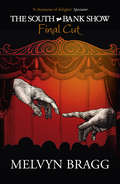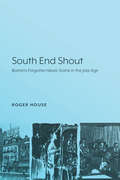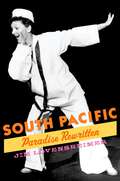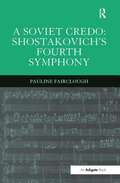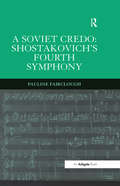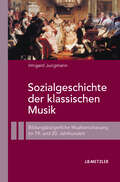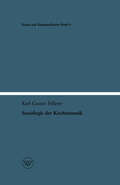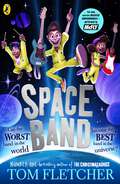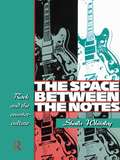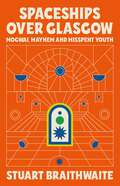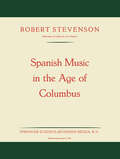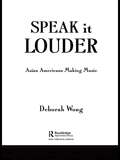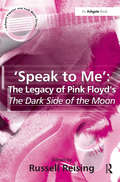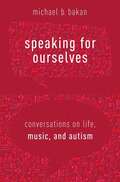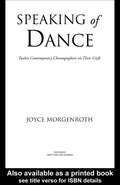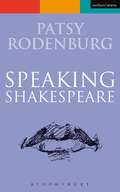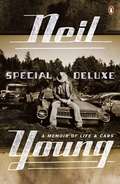- Table View
- List View
The South Bank Show: Final Cut
by Melvyn BraggWhat drives a musician to write extraordinary songs? How do writers create their worlds? How does an actor achieve greatness?For over thirty years of The South Bank Show, Melvyn Bragg has interviewed many of the greatest cultural icons of our age. These interviews offer revelatory insights into the lives and work of writers, actors, artists and musicians. In The South Bank Show: Final Cut he has revisited some of these artists and used the interviews as the basis for fuller portraits.The range of artists is remarkable and this book is true to The South Bank Show’s ethos of seeking out the highest quality whatever the art form.Melvyn Bragg’s unique perspective makes this book indispensable for anyone interested in the work and lives of some of the best artists of our time.
South End Shout: Boston’s Forgotten Music Scene in the Jazz Age
by Roger HouseSouth End Shout: Boston’s Forgotten Music Scene in the Jazz Age details the power of music in the city’s African American community, spotlighting the era of ragtime culture in the early 1900s to the rise of big band orchestras in the 1930s. This story is deeply embedded in the larger social condition of Black Bostonians and the account is brought to life by the addition of 20 illustrations of musicians, theaters, dance halls, phonographs, and radios used to enjoy the music. South End Shout is part of an emerging field of studies that examines jazz culture outside of the major centers of music production. In extensive detail, author Roger R. House covers the activities of jazz musicians, jazz bands, the places they played, the relationships between Black and white musicians, the segregated local branches of the American Federation of Musicians (AFL-CIO), and the economics of Boston’s music industry. Readers will be captivated by the inclusion of vintage local newspaper reports, classified advertisements, and details of hard-to-access oral history accounts by musicians and residents. These precious documentary materials help to understand how jazz culture evolved as a Boston art form and contributed to the national art form between the world wars. With this book, House makes an important contribution to American studies and jazz history. Scholars and general readers alike who are interested in jazz and jazz culture, the history of Boston and its Black culture, and 20th century American and urban studies will be enlightened and delighted by this book.
South Pacific: Paradise Rewritten (Broadway Legacies)
by Jim LovensheimerRodgers and Hammerstein's Tony and Pulitzer Prize-winning musical "South Pacific" has remained a mainstay of the American musical theater since it opened in 1949, and its powerful message about racial intolerance continues to resonate with twenty-first century audiences. Drawing on extensive research in the Rodgers and the Hammerstein papers, including Hammerstein's personal notes on James A. Michener's Tales of the South Pacific, Jim Lovensheimer offers a fascinating reading of "South Pacific" that explores the show's complex messages and demonstrates how the presentation of those messages changed throughout the creative process. Indeed, the author shows how Rodgers and especially Hammerstein continually refined and softened the theme of racial intolerance until it was more acceptable to mainstream Broadway audiences. Likewise, Lovensheimer describes the treatment of gender and colonialism in the musical, tracing how it both reflected and challenged early Cold War Era American norms. The book also offers valuable background to the writing of "South Pacific," exploring the earlier careers of both Rodgers and Hammerstein, showing how they frequently explored serious social issues in their other works, and discussing their involvement in the political movements of their day, such as Hammerstein's founding membership in the Hollywood Anti-Nazi League. Finally, the book features many wonderful appendices, including two that compare the original draft and final form of the classic songs "I'm Gonna Wash That Man Right Out-a My Hair" and "I'm In Love With a Wonderful Guy." Thoroughly researched and compellingly written, this superb book offers a rich, intriguing portrait of a Broadway masterpiece and the era in which it was created.
South Pacific: Paradise Rewritten (Broadway Legacies)
by Jim LovensheimerRodgers and Hammerstein's Tony and Pulitzer Prize-winning musical "South Pacific" has remained a mainstay of the American musical theater since it opened in 1949, and its powerful message about racial intolerance continues to resonate with twenty-first century audiences. Drawing on extensive research in the Rodgers and the Hammerstein papers, including Hammerstein's personal notes on James A. Michener's Tales of the South Pacific, Jim Lovensheimer offers a fascinating reading of "South Pacific" that explores the show's complex messages and demonstrates how the presentation of those messages changed throughout the creative process. Indeed, the author shows how Rodgers and especially Hammerstein continually refined and softened the theme of racial intolerance until it was more acceptable to mainstream Broadway audiences. Likewise, Lovensheimer describes the treatment of gender and colonialism in the musical, tracing how it both reflected and challenged early Cold War Era American norms. The book also offers valuable background to the writing of "South Pacific," exploring the earlier careers of both Rodgers and Hammerstein, showing how they frequently explored serious social issues in their other works, and discussing their involvement in the political movements of their day, such as Hammerstein's founding membership in the Hollywood Anti-Nazi League. Finally, the book features many wonderful appendices, including two that compare the original draft and final form of the classic songs "I'm Gonna Wash That Man Right Out-a My Hair" and "I'm In Love With a Wonderful Guy." Thoroughly researched and compellingly written, this superb book offers a rich, intriguing portrait of a Broadway masterpiece and the era in which it was created.
A Soviet Credo: Shostakovich's Fourth Symphony
by Pauline FaircloughComposed in 1935-36 and intended to be his artistic 'credo', Shostakovich's Fourth Symphony was not performed publicly until 1961. Here, Dr Pauline Fairclough tackles head-on one of the most significant and least understood of Shostakovich's major works. She argues that the Fourth Symphony was radically different from its Soviet contemporaries in terms of its structure, dramaturgy, tone and even language, and therefore challenged the norms of Soviet symphonism at a crucial stage of its development. With the backing of prominent musicologists such as Ivan Sollertinsky, the composer could realistically have expected the premiere to have taken place, and may even have intended the symphony to be a model for a new kind of 'democratic' Soviet symphonism. Fairclough meticulously examines the score to inform a discussion of tonal and thematic processes, allusion, paraphrase and reference to musical types, or intonations. Such analysis is set deeply in the context of Soviet musical culture during the period 1932-36, involving Shostakovich's contemporaries Shebalin, Myaskovsky, Kabalevsky and Popov. A new method of analysis is also advanced here, where a range of Soviet and Western analytical methods are informed by the theoretical work of Shostakovich's contemporaries Viktor Shklovsky, Boris Tomashevsky, Mikhail Bakhtin and Ivan Sollertinsky, together with Theodor Adorno's late study of Mahler. In this way, the book will significantly increase an understanding of the symphony and its context.
A Soviet Credo: Shostakovich's Fourth Symphony (PDF)
by Pauline FaircloughComposed in 1935-36 and intended to be his artistic 'credo', Shostakovich's Fourth Symphony was not performed publicly until 1961. Here, Dr Pauline Fairclough tackles head-on one of the most significant and least understood of Shostakovich's major works. She argues that the Fourth Symphony was radically different from its Soviet contemporaries in terms of its structure, dramaturgy, tone and even language, and therefore challenged the norms of Soviet symphonism at a crucial stage of its development. With the backing of prominent musicologists such as Ivan Sollertinsky, the composer could realistically have expected the premiere to have taken place, and may even have intended the symphony to be a model for a new kind of 'democratic' Soviet symphonism. Fairclough meticulously examines the score to inform a discussion of tonal and thematic processes, allusion, paraphrase and reference to musical types, or intonations. Such analysis is set deeply in the context of Soviet musical culture during the period 1932-36, involving Shostakovich's contemporaries Shebalin, Myaskovsky, Kabalevsky and Popov. A new method of analysis is also advanced here, where a range of Soviet and Western analytical methods are informed by the theoretical work of Shostakovich's contemporaries Viktor Shklovsky, Boris Tomashevsky, Mikhail Bakhtin and Ivan Sollertinsky, together with Theodor Adorno's late study of Mahler. In this way, the book will significantly increase an understanding of the symphony and its context.
A Soviet Credo: Shostakovich's Fourth Symphony
by Pauline FaircloughComposed in 1935-36 and intended to be his artistic 'credo', Shostakovich's Fourth Symphony was not performed publicly until 1961. Here, Dr Pauline Fairclough tackles head-on one of the most significant and least understood of Shostakovich's major works. She argues that the Fourth Symphony was radically different from its Soviet contemporaries in terms of its structure, dramaturgy, tone and even language, and therefore challenged the norms of Soviet symphonism at a crucial stage of its development. With the backing of prominent musicologists such as Ivan Sollertinsky, the composer could realistically have expected the premiere to have taken place, and may even have intended the symphony to be a model for a new kind of 'democratic' Soviet symphonism. Fairclough meticulously examines the score to inform a discussion of tonal and thematic processes, allusion, paraphrase and reference to musical types, or intonations. Such analysis is set deeply in the context of Soviet musical culture during the period 1932-36, involving Shostakovich's contemporaries Shebalin, Myaskovsky, Kabalevsky and Popov. A new method of analysis is also advanced here, where a range of Soviet and Western analytical methods are informed by the theoretical work of Shostakovich's contemporaries Viktor Shklovsky, Boris Tomashevsky, Mikhail Bakhtin and Ivan Sollertinsky, together with Theodor Adorno's late study of Mahler. In this way, the book will significantly increase an understanding of the symphony and its context.
A Soviet Credo: Shostakovich's Fourth Symphony
by Pauline FaircloughComposed in 1935-36 and intended to be his artistic 'credo', Shostakovich's Fourth Symphony was not performed publicly until 1961. Here, Dr Pauline Fairclough tackles head-on one of the most significant and least understood of Shostakovich's major works. She argues that the Fourth Symphony was radically different from its Soviet contemporaries in terms of its structure, dramaturgy, tone and even language, and therefore challenged the norms of Soviet symphonism at a crucial stage of its development. With the backing of prominent musicologists such as Ivan Sollertinsky, the composer could realistically have expected the premiere to have taken place, and may even have intended the symphony to be a model for a new kind of 'democratic' Soviet symphonism. Fairclough meticulously examines the score to inform a discussion of tonal and thematic processes, allusion, paraphrase and reference to musical types, or intonations. Such analysis is set deeply in the context of Soviet musical culture during the period 1932-36, involving Shostakovich's contemporaries Shebalin, Myaskovsky, Kabalevsky and Popov. A new method of analysis is also advanced here, where a range of Soviet and Western analytical methods are informed by the theoretical work of Shostakovich's contemporaries Viktor Shklovsky, Boris Tomashevsky, Mikhail Bakhtin and Ivan Sollertinsky, together with Theodor Adorno's late study of Mahler. In this way, the book will significantly increase an understanding of the symphony and its context.
Sozialgeschichte der klassischen Musik: Bildungsbürgerliche Musikanschauung im 19. und 20. Jahrhundert
by Irmgard JungmannBildungsbürger und klassische Musik. Mit der Entstehung des Bildungsbürgertums Ende des 18. Jahrhunderts entfaltete sich eine ganz neue musikalische Öffentlichkeit. Ob im privaten Salon, im Chor oder bei öffentlichen Konzerten klassische Musik diente dazu, sich von Trivialmusik und somit von den unteren Gesellschaftsschichten abzugrenzen. Im 20. Jahrhundert wurde die Frage nach der Teilhabe breiterer Schichten an der klassischen Musik zum bedeutenden Motor des Musiklebens und der Kulturpolitik.
Soziologie der Kirchenmusik: Materialien zur Musik- und Religionssoziologie (Kunst und Kommunikation #9)
by Karl Gustav FellererSpace Band: The out-of-this-world new adventure from the number-one-bestselling author Tom Fletcher
by Tom FletcherThe out-of-this-world new adventure from number-one-bestselling author of The Danger Gang and The Christmasaurus: Tom Fletcher.George, Neila and Bash are the worst band on Earth. George wants them to be brilliant - but Neila has stage fright, and Bash is too distracted by his obsession with stars, aliens and faraway planets. But what they lack in talent and confidence, they make up for in heart.They're determined to blow their friends away at their school Battle of the Bands contest. But the moment they start to play...They're beamed up into space!!!Now the kids face an even bigger challenge: Battle of the Bands, but the intergalactic version. They're competing against alien bands from every galaxy! And if they don't win, they might never make it home again...Can the worst band on Earth become the best band in the universe?An intergalactically awesome tale of celebrating difference, believing in yourself, and the power of friendship.Listen to the intergalactically awesome SPACE BAND soundtrack now, performed by McFLY!
The Space Between the Notes: Rock and the Counter-Culture
by Sheila WhiteleyThe Space Between the Notes examines a series of relationships central to sixties counter-culture: psychedelic coding and rock music, the Rolling Stones and Charles Manson, the Beatles and the `Summers of love', Jimi Hendrix and hallucinogenics, Pink Floyd and space rock. Sheila Whiteley combines musicology and socio-cultural analysis to illuminate this terrain, illustrating her argument with key recordings of the time: Cream's She Walks Like a Bearded Rainbow, Hendrix's Hey Joe, Pink Floyd's Set the Controls For the Heat of the Sun, The Move's I Can Hear the Grass Grow, among others.The appropriation of progressive rock by young urban dance bands in the 1990s make this study of sixties and seventies counter-culture a timely intervention. It will inform students of popular music and culture, and spark off recognition and interest from those that lived through the period as well as a new generation that draw inspiration from its iconography and sensibilities today.
The Space Between the Notes: Rock and the Counter-Culture
by Sheila WhiteleyThe Space Between the Notes examines a series of relationships central to sixties counter-culture: psychedelic coding and rock music, the Rolling Stones and Charles Manson, the Beatles and the `Summers of love', Jimi Hendrix and hallucinogenics, Pink Floyd and space rock. Sheila Whiteley combines musicology and socio-cultural analysis to illuminate this terrain, illustrating her argument with key recordings of the time: Cream's She Walks Like a Bearded Rainbow, Hendrix's Hey Joe, Pink Floyd's Set the Controls For the Heat of the Sun, The Move's I Can Hear the Grass Grow, among others.The appropriation of progressive rock by young urban dance bands in the 1990s make this study of sixties and seventies counter-culture a timely intervention. It will inform students of popular music and culture, and spark off recognition and interest from those that lived through the period as well as a new generation that draw inspiration from its iconography and sensibilities today.
Spaceships Over Glasgow: Mogwai, Mayhem and Misspent Youth
by Stuart BraithwaiteBorn the son of Scotland's last telescope-maker, Stuart Braithwaite was perhaps always destined for a life of psychedelic adventuring on the furthest frontiers of noise in MOGWAI, one of the best loved and most ground-breaking post-rock bands of the past three decades.Modestly delinquent at school, Stuart developed an early appetite for 'alternative' music in what might arguably be described as its halcyon days, the late '80s. Discovering bands like Sonic Youth, My Bloody Valentine, and Jesus and Mary Chain, and attending seminal gigs (often incongruously incognito as a young girl with long hair to compensate for his babyface features) by The Cure and Nirvana, Stuart compensated for his indifference to school work with a dedication to rock and roll . . . and of course the fledgling hedonism that comes with it.Spaceships Over Glasgow is a love song to live rock and roll; to the passionate abandon we've all felt in the crowd (and some of us, if lucky enough, from the stage) at a truly incendiary gig. It is also the story of a life lived on the edge; of the high-times and hazardous pit-stops of international touring with a band of misfits and miscreants.
Spanian: The Unfiltered Hood Life
by SpanianBy the time he was twelve, Spanian knew he would follow his family's footsteps to become a career criminal. What followed was a decade-long string of brazen crimes and brutal violence: stabbings, ram-raids, drug runs and a notorious high school siege. Throughout the Sydney social housing enclaves of Redfern, Waterloo and Woolloomooloo, Spanian earned a reputation as one of the city's most flagrant crooks; armed with a boxcutter in one hand, and a syringe in the other.But it all came at a damning price: in the throes of heroin addiction and thirteen years wasted behind bars, Spanian became a longstanding resident of jails across New South Wales. There, he was embroiled in racial divisions, prison politics, and a vicious vortex of self-destruction, until music and books became an unlikely lifeline. Reading and rapping became new rituals, and a glistening light at the end of the tunnel. Released from Bathurst Correctional Centre in 2017 with newfound purpose, Spanian has since found viral fame and a sprawling, worldwide audience through hip-hop and his magnetic social media presence.This is the powerful, unflinching and high-octane memoir of how a young inner-city kid became Spanian. It gives unapologetic insight into the gritty socio-economic underbelly of Sydney city, the criminal justice system, and the correctional system. The story of Spanian provides hope that even the most stubborn cycles can be broken, and new dreams made.
Speak it Louder: Asian Americans Making Music
by Deborah WongSpeak It Louder: Asian Americans Making Music documents the variety of musics-from traditional Asian through jazz, classical, and pop-that have been created by Asian Americans. This book is not about "Asian American music" but rather about Asian Americans making music. This key distinction allows the author to track a wide range of musical genres. Wong covers an astonishing variety of music, ethnically as well as stylistically: Laotian song, Cambodian music drama, karaoke, Vietnamese pop, Japanese American taiko, Asian American hip hop, and panethnic Asian American improvisational music (encompassing jazz and avant-garde classical styles). In Wong's hands these diverse styles coalesce brilliantly around a coherent and consistent set of questions about what it means for Asian Americans to make music in environments of inter-ethnic contact, about the role of performativity in shaping social identities, and about the ways in which commercially and technologically mediated cultural production and reception transform individual perceptions of time, space, and society. Speak It Louder: Asian Americans Making Music encompasses ethnomusicology, oral history, Asian American studies, and cultural performance studies. It promises to set a new standard for writing in these fields, and will raise new questions for scholars to tackle for many years to come.
Speak it Louder: Asian Americans Making Music
by Deborah WongSpeak It Louder: Asian Americans Making Music documents the variety of musics-from traditional Asian through jazz, classical, and pop-that have been created by Asian Americans. This book is not about "Asian American music" but rather about Asian Americans making music. This key distinction allows the author to track a wide range of musical genres. Wong covers an astonishing variety of music, ethnically as well as stylistically: Laotian song, Cambodian music drama, karaoke, Vietnamese pop, Japanese American taiko, Asian American hip hop, and panethnic Asian American improvisational music (encompassing jazz and avant-garde classical styles). In Wong's hands these diverse styles coalesce brilliantly around a coherent and consistent set of questions about what it means for Asian Americans to make music in environments of inter-ethnic contact, about the role of performativity in shaping social identities, and about the ways in which commercially and technologically mediated cultural production and reception transform individual perceptions of time, space, and society. Speak It Louder: Asian Americans Making Music encompasses ethnomusicology, oral history, Asian American studies, and cultural performance studies. It promises to set a new standard for writing in these fields, and will raise new questions for scholars to tackle for many years to come.
'Speak to Me': The Legacy of Pink Floyd's The Dark Side of the Moon
by Russell ReisingThe endurance of Pink Floyd's The Dark Side of the Moon on the Billboard Top 100 Chart is legendary, and its continuing sales and ongoing radio airplay ensure its inclusion on almost every conceivable list of rock's greatest albums. This collection of essays provides indispensable studies of the monumental 1973 album from a variety of musical, cultural, literary and social perspectives. The development and change of the songs is considered closely, from the earliest recordings through to the live, filmed performance at London's Earls Court in 1994. The band became almost synonymous with audio-visual innovations, and the performances of the album at live shows were spectacular moments of mass-culture although Roger Waters himself spoke out against such mass spectacles. The band's stage performances of the album serve to illustrate the multifaceted and complicated relationship between modern culture and technology. The album is therefore placed within the context of developments in late 1960s/early 1970s popular music, with particular focus on the use of a variety of segues between tracks which give the album a multidimensional unity that is lacking in Pink Floyd's later concept albums. Beginning with 'Breathe' and culminating in 'Eclipse', a tonal and motivic coherence unifies the structure of this modern song cycle. The album is also considered in the light of modern day 'tribute' bands, with a discussion of the social groups who have the strongest response to the music being elaborated alongside the status of mediated representations and their relation to the 'real' Pink Floyd.
'Speak to Me': The Legacy of Pink Floyd's The Dark Side of the Moon
by Russell ReisingThe endurance of Pink Floyd's The Dark Side of the Moon on the Billboard Top 100 Chart is legendary, and its continuing sales and ongoing radio airplay ensure its inclusion on almost every conceivable list of rock's greatest albums. This collection of essays provides indispensable studies of the monumental 1973 album from a variety of musical, cultural, literary and social perspectives. The development and change of the songs is considered closely, from the earliest recordings through to the live, filmed performance at London's Earls Court in 1994. The band became almost synonymous with audio-visual innovations, and the performances of the album at live shows were spectacular moments of mass-culture although Roger Waters himself spoke out against such mass spectacles. The band's stage performances of the album serve to illustrate the multifaceted and complicated relationship between modern culture and technology. The album is therefore placed within the context of developments in late 1960s/early 1970s popular music, with particular focus on the use of a variety of segues between tracks which give the album a multidimensional unity that is lacking in Pink Floyd's later concept albums. Beginning with 'Breathe' and culminating in 'Eclipse', a tonal and motivic coherence unifies the structure of this modern song cycle. The album is also considered in the light of modern day 'tribute' bands, with a discussion of the social groups who have the strongest response to the music being elaborated alongside the status of mediated representations and their relation to the 'real' Pink Floyd.
Speaking For Ourselves: Conversations On Life, Music, And Autism
by Michael B. Bakan Dotan Nitzberg Mara Chasar Graeme Gibson Elizabeth J. Grace Zena Hamelson Gordon PetersonSince advent of autism as a diagnosed condition in the 1940s, the importance of music in the lives of autistic people has been widely observed and studied. Articles on musical savants, extraordinary feats of musical memory, unusually high rates of absolute or "perfect" pitch, and the effectiveness of music-based therapies abound in the autism literature. Meanwhile, music scholars and historians have posited autism-centered explanatory models to account for the unique musical artistry of everyone from Béla Bartók and Glenn Gould to "Blind Tom" Wiggins. Given the great deal of attention paid to music and autism, it is surprising to discover that autistic people have rarely been asked to account for how they themselves make and experience music or why it matters to them that they do. In Speaking for Ourselves, renowned ethnomusicologist Michael Bakan does just that, engaging in deep conversations - some spanning the course of years - with ten fascinating and very different individuals who share two basic things in common: an autism spectrum diagnosis and a life in which music plays a central part. These conversations offer profound insights into the intricacies and intersections of music, autism, neurodiversity, and life in general, not from an autistic point of view, but rather from many different autistic points of view. They invite readers to partake of a rich tapestry of words, ideas, images, and musical sounds (on the companion website) that speak to both the diversity of autistic experience and the common humanity we all share.
Speaking of Dance: Twelve Contemporary Choreographers on Their Craft
by Joyce MorgenrothSpeaking of Dance: Twelve Contemporary Choreographers on Their Craft delves into the choreographic processes of some of America's most engaging and revolutionary dancemakers. Based on personal interviews, the book's narratives reveal the methods and quests of, among others, Merce Cunningham, Meredith Monk, Bill T. Jones, Trisha Brown, and Mark Morris. Morgenroth shows how the ideas, craft, and passion that go into their work have led these choreographers to disrupt known forms and expectations. The history of dance in the making is revealed through the stories of these intelligent, articulate, and witty dance masters.
Speaking of Dance: Twelve Contemporary Choreographers on Their Craft
by Joyce MorgenrothSpeaking of Dance: Twelve Contemporary Choreographers on Their Craft delves into the choreographic processes of some of America's most engaging and revolutionary dancemakers. Based on personal interviews, the book's narratives reveal the methods and quests of, among others, Merce Cunningham, Meredith Monk, Bill T. Jones, Trisha Brown, and Mark Morris. Morgenroth shows how the ideas, craft, and passion that go into their work have led these choreographers to disrupt known forms and expectations. The history of dance in the making is revealed through the stories of these intelligent, articulate, and witty dance masters.
Special Deluxe: Mi Vida Al Volante
by Neil YoungSpecial Deluxe by Neil Young - the second installment of the iconic musician's memoirsQuirky and wonderfully candid, Neil Young's new book of reminiscences is as compelling as his first book. He returns with more unforgettable stories about his six decades in the music business - but this is not your average rock biography. He centres this new work on one of his life's passions, cars, using the framework of all the cars he's ever owned to construct a narrative of his life and career, exploring and demonstrating how memories are attached to objects. Young also expresses regret for the environmental impact of his past cars, and now passionately advocates the use of clean energy.Special Deluxe is a mix of memoir and environmental politics by one of the most gifted and influential artists of our time.The next installment of Neil Young's memoir after Waging Heavy Peace, Special Deluxe is essential reading for his fans and will also appeal to readers of Life by Keith Richards and Chronicles by Bob Dylan.'Not your average rock-star autobiography .... Young is a natural obsessive and a bit cantankerous, which makes an interesting combination' Richard Williams, Guardian'Waging Heavy Peace is as charismatically off the wall as Neil Young's records' Janet Maslin, New York TimesNeil Young's music and songwriting span forty years, and his 34 studio albums are among the most enduring and popular in modern times. Born and raised in Canada, long resident in California, he has been uniquely inducted twice into the Rock and Roll Hall of Fame. He is also well-known as a political activist, environmentalist and philanthropist, co-founding Farm Aid and The Bridge School for educationally impaired children.
